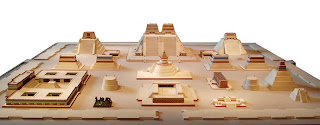This week’s blog, I travelled to the ancient city of
Tenochtitlan and modern day Mexico City using Google maps. The reason for this
visit was to compare the size and scale of the Aztec capital to the colonial
Mexican capital, and to generate my own reasons for why Tenochtitlan was buried
under the Mexican capital.
Model of Tenochtitlan.
http://www.tenochtitlanfacts.com/.
The Aztec imperial capital of Tenochtitlan stood out
as the largest urban center in the twelfth to fifteenth century. Organized into
quadrants, it spanned over twelve kilometers squared. Unfortunately, between
1519 and 1521, this magnificent city experienced a massive fall due to Spanish take
over lead by Hernán Cortés. Following the destruction of Tenochtitlan, the
Spaniards decided to build their own metropolis over the ruins in a more
European style. The size of Mexico City has far exceeded the size of
Tenochtitlan due to the ever expanding population. Most of the buildings in
Tenochtitlan were torn down by the invaders in order to incorporate more
buildings and housing. However, through recent excavation, Templo Mayor (the
Great Temple) and other artifacts were revealed beneath Mexico City.
I believe the Spanish conquered the area and built
on top of the ruins because at the time, Tenochtitlan’s size, power, wealth,
and legitimacy were very enviable. Being the biggest of all the Aztec cities
draws in a lot of focus not just because it was considered the main administrative
center and marketplace, but it also poses as a target for attack.
It would show the strength and power of an incoming army if it was able to conquer
and dismember such a massive empire. Therefore, building on top of Tenochtitlan
could have signalled new order.
Another reason that could have fuelled the extensive effort of Spanish
leader to destroy the remains of Tenochtitlan could be because he wanted to
purge the old city of their religious/cosmological beliefs. This would allow
for Christianity to be incorporated into the new city as the preferred religion
for the inhabitants.
Whatever the reason may be, it is sad that so much of the history of
Tenochtitlan, found in the ruins, is lost because of the Spanish takeover to
build Mexico City.
Works Citied
History
and Facts About Tenochtitlan. http://www.tenochtitlanfacts.com/.
King,
Heidi. "Tenochtitlan". In Heilbrunn Timeline of Art History.
New York: The Metropolitan Museum of Art, 2000–. http://www.metmuseum.org/toah/hd/teno_1/hd_teno_1.htm
(October
2004).

No comments:
Post a Comment